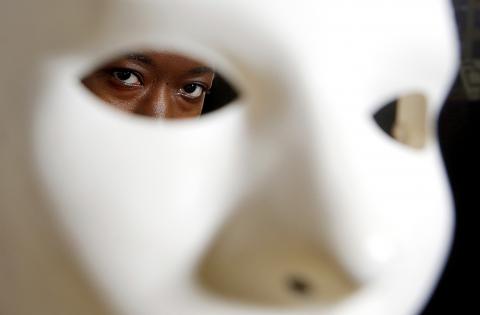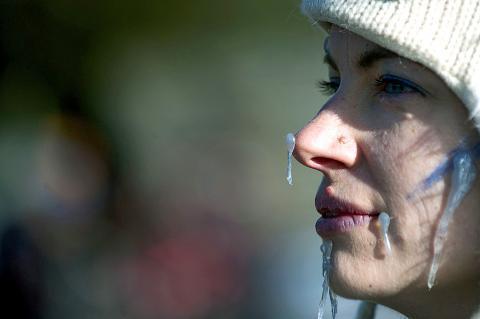David Whitlock has not showered or bathed for 15 years, yet he does not have body odor.
“It was kind of strange for the first few months, but after that I stopped missing it,” he says. “If I get a specific part of my body dirty, then I’ll wash that specific part” — but never with soap.
As well as germs, soap gets rid of the skin’s protective oils and alters its pH level. Although Whitlock appreciated gaining an extra 15 minutes a day from soap-dodging, his primary motivation was to encourage friendly microbes to live on him in symbiotic harmony. The bacteria get to feast on the ammonia from his sweat and he gets low-maintenance, balanced skin.

Photo: AP
SKIN MICROBIOME
Just as awareness of the importance of the gut microbiome has led to a boom in probiotic and fermented foods and supplements, there is increasing interest in our skin microbiome: the trillions of microbes that protect us from pathogens and keep us healthy by making vitamins and other useful chemicals. In this unprecedentedly sanitized era, in which eczema, acne and problems associated with dry skin are rife, consumers are hungry for solutions. Even the mainstream brand Dove claims vaguely that its products are “microbiome-gentle.”
Sarah Ballantyne, a medical biophysicist turned author and lifestyle guru known as the Paleo Mom, has been an advocate of living in a more “stone age” way since reaching a healthy weight after adopting the Paleo diet. She, too, uses only water to wash, even though she is “at the gym sweating buckets six hours a week.”

Photo: AFP
“I use coconut oil to shave and that’s it,” she says. “Over time, my skin has adjusted. I don’t smell.” She is working on a book about the human microbiome and is convinced her odor-free armpits are a sign that her skin microbiome is healthy.
Jackie Hong, a reporter in Yukon, north-west Canada, has eschewed soap in the shower for nine years. “I use my hands to scrub myself and get any grime off, but I’m sitting in court or at my desk most days, so it’s not like I’m getting bombarded with filth.”
She was curious to go without soap after an artist told her that he hadn’t lathered up in 20 years. She says she saves time and money and needs “a lot less body lotion.”
“There’s nothing wrong with just rinsing,” says Sandy Skotnicki, a Toronto-based dermatologist and the author of the book Beyond Soap. “I’ve talked to people who haven’t used any kind of detergent in years and they’re perfectly fine.”
She says that, since 1950, we have gone from bathing once a week to every day.
“Has that changed our skin microbiome? I think the answer is yes. And has that caused a rise in inflammatory skin diseases? I think the answer is yes, but we don’t know.”
MICROBIOME-FRIENDLY PRODUCTS
For Whitlock, a former chemical engineer based in Cambridge, Massachusetts, not washing has been a serious science experiment, the success of which has led him to become a trailblazer in a skincare revolution in soap-free, microbiome-friendly and probiotic products. His inspiration came from researching why horses roll in dirt. His conclusion? To top up their ammonia-metabilising bacteria, making the skin less susceptible to infection.
Whitlock had hoped that he would naturally acquire this type of bacteria simply by stopping washing. He didn’t — and grew quite smelly. So, he harvested bacteria from the soil at a local farm and fed them with ammonia and minerals. When they turned the ammonia into nitrate, he knew he had what he wanted and started narrowing them down to a single strain that seemed happiest on human skin. After he applied the bacteria he had cultured — the stuff the horses were apparently after — he stopped smelling.
After co-founding the company AOBiome in 2013, Whitlock launched it as a spray: Mother Dirt AO+ Mist, billed as containing “ammonia-oxidising bacteria (AOB), a peacekeeper that once existed on our skin, but was cleaned away with modern hygiene and lifestyles.”
As most people still want to take showers and purchase nice products for their skin, the Mother Dirt range now includes hair, face and body washes free from preservatives and detergents.
Michelle Strutton, a global beauty analyst at the research firm Mintel, says that while probiotic skincare still has a low market share, it has increased more than 300 percent from 2015 to this year, “so it is definitely an area that’s worth watching.”
For example, the French brand Gallinee uses lactobacillus bacteria “deactivated by heat,” while LaFlore, a US brand soon to launch in the UK, suspends microbes in a “gel matrix.” What exactly makes a product “microbiome-friendly” or “probiotic”, however, can be hard to pin down.
“There isn’t a whole lot of definition for things like natural probiotics,” says Kit Wallen Russell, the co-founder of the British startup JooMo. “There’s no regulation in the cosmetics industry, which means it’s the wild west for companies saying their products do certain things.”
JooMo’s products don’t contain live cultures, but they are preservative-free and, Wallen Russell says, create the conditions for microbes to be attracted from the environment.
Hard evidence is lacking in this field. There are no studies demonstrating the negative effects of soap or overwashing.
“It sounds like something people just say and pass around like: ‘Well, that makes sense to me,’” says Julie Segre, a senior investigator in microbial genomics at the National Institute of Health in the US. She says there is limited medical evidence for the efficacy of skincare targeting the microbiome.
“My position is there’s a lot of promise in this field, but we need a lot more basic science.”
Even in her own clinical work with childhood eczema, she says, there is a long way to go before microbes could become part of medical intervention — although that is not to say there is no potential. Segre singles out the possibilities of prebiotic ingredients “where you put creams on your skin that can help the beneficial microbes grow.”
While Mother Dirt, as a cosmetic brand, makes no health claims, its owner, AOBiome, is a pharmaceutical company running clinical trials on a surprising array of treatments: not only acne, eczema and rosacea, but also allergic rhinitis, hypertension and migraine. Whitlock says that, after using AOB, he was able to stop taking a drug for his high blood pressure, a result that was replicated in AOBiome’s acne study.
“When we looked at the safety data, people’s blood pressure dropped,” says Jim Hoffman, one of the company’s directors. “Nobody’s blood pressure dropped dangerously. All of a sudden, you’re looking at hundreds of people and saying there’s really something here.”
In the resulting blood pressure study, it was observed that no one trialling AOB treatment had had a headache.
“In the placebo group, people had the normal number of headaches, but in the drug group: zero headaches,” says Hoffman. A hypothesis for a migraine treatment evolved from there. Trials are continuing.
Meanwhile, the jury is out on the best way to ensure a healthy skin microbiome. Mother Dirt’s CEO, the biochemist Jasmina Aganovic, says detergents such as sodium lauryl sulphate and sodium dodecyl sulphate should be avoided, so as to protect the sensitive AOB. Even essential oils, such as lavender and tea tree, have antimicrobial capabilities.
“It doesn’t mean you shouldn’t use them, but you need to be careful about how — not all over the body, not super-concentrated,” she says.
Spending time outdoors, and “forest bathing” in particular, has also been shown to be beneficial to the microbiome. But, Aganovic hastens to add: “The tempered approach of the scientist is there’s a lot we don’t know, and we’re excited about the potential, but we must also be careful not to overclaim.”
There is one area where most agree that soap is still useful. Ballantyne continues to reach for soap for hand washing, but opts for a lower pH type. Segre also recommends hand-washing with soap. As Skotnicki puts it: “Washing your hair and your body has very little to do with hygiene. But washing your hands is essential.”

Sept. 1 to Sept. 7 In 1899, Kozaburo Hirai became the first documented Japanese to wed a Taiwanese under colonial rule. The soldier was partly motivated by the government’s policy of assimilating the Taiwanese population through intermarriage. While his friends and family disapproved and even mocked him, the marriage endured. By 1930, when his story appeared in Tales of Virtuous Deeds in Taiwan, Hirai had settled in his wife’s rural Changhua hometown, farming the land and integrating into local society. Similarly, Aiko Fujii, who married into the prominent Wufeng Lin Family (霧峰林家) in 1927, quickly learned Hoklo (commonly known as Taiwanese) and

The low voter turnout for the referendum on Aug. 23 shows that many Taiwanese are apathetic about nuclear energy, but there are long-term energy stakes involved that the public needs to grasp Taiwan faces an energy trilemma: soaring AI-driven demand, pressure to cut carbon and reliance on fragile fuel imports. But the nuclear referendum on Aug. 23 showed how little this registered with voters, many of whom neither see the long game nor grasp the stakes. Volunteer referendum worker Vivian Chen (陳薇安) put it bluntly: “I’ve seen many people asking what they’re voting for when they arrive to vote. They cast their vote without even doing any research.” Imagine Taiwanese voters invited to a poker table. The bet looked simple — yes or no — yet most never showed. More than two-thirds of those

In the run-up to the referendum on re-opening Pingtung County’s Ma-anshan Nuclear Power Plant last month, the media inundated us with explainers. A favorite factoid of the international media, endlessly recycled, was that Taiwan has no energy reserves for a blockade, thus necessitating re-opening the nuclear plants. As presented by the Chinese-language CommonWealth Magazine, it runs: “According to the US Department of Commerce International Trade Administration, 97.73 percent of Taiwan’s energy is imported, and estimates are that Taiwan has only 11 days of reserves available in the event of a blockade.” This factoid is not an outright lie — that

Former Chinese Nationalist Party (KMT) chairwoman Hung Hsiu-chu’s (洪秀柱) attendance at the Chinese Communist Party’s (CPP) “Chinese People’s War of Resistance Against Japanese Aggression and the World Anti-Fascist War” parade in Beijing is infuriating, embarrassing and insulting to nearly everyone in Taiwan, and Taiwan’s friends and allies. She is also ripping off bandages and pouring salt into old wounds. In the process she managed to tie both the KMT and the Democratic Progressive Party (DPP) into uncomfortable knots. The KMT continues to honor their heroic fighters, who defended China against the invading Japanese Empire, which inflicted unimaginable horrors on the